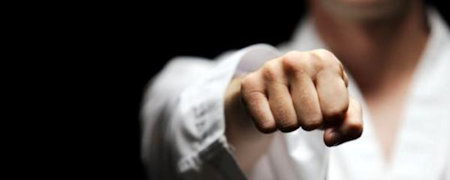Karaté - Budo |
Eléments essentiels à la compréhension du karaté |
 |
History |
|
In our attempts to understand karate, let us first turn to its origins.
1. The Legend of Bodhidharma Legend has it that, around the year 500, Bodhidharma (originally from India) settled at Shaolin temple in the north of China. He noticed that, due to a lack of physical movement, the monks found it hard to endure the stillness imposed on them by Buddhist meditation. Bodhidharma taught them martial physical exercises (which he had studied with his father) as a way of strengthening their bodies. His father had been king and knew a fighting art that resembled kalaripayattu. This method is thought to have influenced most Chinese and Asian martial arts. The approach was disseminated during the invasion of Shaolin temple: the monks were forced to flee and spread their expertise throughout China. However, the practice of martial arts was already well developed in China long before the arrival of Bodhidharma. Eight hundred years earlier, Sunzi, a Chinese general, had written on the Art of The Fist (Quanfa or Chuan Fa) in sections of The Art of War. Accordingly, the real influence of Bodhidharma on the development of Chinese martial arts needs to be put into perspective.
2. On the Island of Okinawa Around the year 1400, King Sho Hashi unified Okinawa and banned the possession of weapons for fear of riots. Two hundred years later, after the island was invaded by the Satsuma clan, weapons were once more forbidden by the Japanese government. These successive restrictions contributed to the evolution of fighting techniques using bare hands. Kobudo (fighting using everyday tools) grew in parallel, and among the traditional weapons of Okinawa we find the bo (shepherd’s stick), the nunchaku (a flail used for threshing wheat), the saï (a trident used for planting rice), the tonfa (a millstone handle), etc. The island of Okinawa is located in the Ryu Kyu archipelago off the south coast of China. As a result of this proximity, trade and cultural ties between the two peoples were frequent. The people of Okinawa had their own fighting techniques, but the Chinese influence on the development of karate should not be called into question, as the similarities with the Chinese martial arts are great. In addition, numerous masters of karate from Okinawa stayed in China, as was the case with Kanryo Higaonna, an expert in Naha-te, and his disciple, Chojun Miyagi, the founder of Goju-ryu. Sakugawa Kanga and Sokon Matsumura (the father of Shorin-ryu) also travelled throughout China and were influenced by the Shaolin quan (the fists of Shaolin). More recently, Kanbun Uechi, the founder of Uechi ryu, lived in China for many years. From the 15th to 19th century, the martial art of Okinawa was called To-Te (hand from China) and then Okinawa-Te (hand from Okinawa) or simply Te (hand). In the early 20th century, the Okinawan pronunciation of To-Te was replaced by the Japanese pronunciation: “karate” which has always signified “hand from China”. Shuri and Naha were the two biggest towns in Okinawa, and the two main currents of Te were called Shuri-Te and Naha-Te (hand from Shuri and hand from Naha). Tomari was a town located between Shuri and Naha: Tomari-Te combines the techniques of Shuri and Naha. From the 18th to the 19th century, the practice of Te was forbidden under the Japanese occupation and lessons were given in secret. Te opened up to the public in the mid 19th century thanks to Sokon Matsumura, heir to the Shuri-te and founder of Shorin-ryu, and bodyguard of the last three kings of Okinawa. With the exception of Kanryo Higaonna and his successor, Chojun Miyagi, most of the great Te experts of the late 19th and early 20th century (including Chotoku Kyan, Azato Yasutsune, Kentsu Yabu, Anko Itosu, Chibana Shoshin, Gichin Funakoshi and Kenwa Mabuni) were direct or indirect disciples of Sokon Matsumura. Karate expanded thanks to masters such as Matsumura and his main disciple, Itosu. The latter devised and developed a genuine educational method for karate. In about 1900, Itosu used his influence to introduce karate into the Okinawa school curriculum. 3. Conquering Japan Following a demonstration in front of the Crown Prince of Japan, and to satisfy the request of Jigoro Kano, the founder of judo, Gichin Funakoshi left Okinawa for Tokyo in 1922 to teach karate there... Read more in the book "Karate: more than the move" . |
| Informations on the book >>> |
| Budo editions >>> |